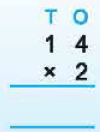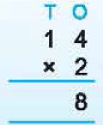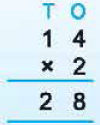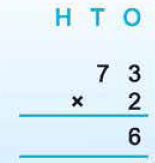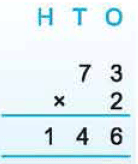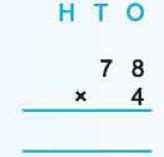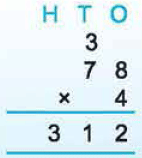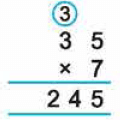Class 3 Maths - Multiplication - Question Answers
Question 1: Multiply 14 by 2.
Step 1: Arrange the numbers in columns.
Step 2: First multiply the ones digit by 2. 4 x 2 = 8. So, write 8 in the ones column.
Step 3: Next multiply the tens digits by 2. 1 x 2 = 2. So, we write 2 in the tens column.
Hence, 14 x 2 = 28
Question 2: Multiply 25 by 3.
Step 1: Write the numbers in columns.
Step 2: First multiply the ones digit by 3. 5 ones x 3 = 15 ones= 1 ten + 5 ones. So, we write 5 in the ones column and cany over 1 to the tens place.
Step 3: Next multiply the tens digit by 3. 2 tens x 3 = 6 tens. Add 1 ten (carried) to 6 tens. 6 tens + 1 ten = 7 tens. We write 7 in the tens column. So, 25 x 3 = 75
Hence, 25 x 3 = 75.
Question 3: Multiply 73 by 2.
Step 1: Write the numbers in columns.
Step 2: First multiply the ones digit by 2. 3 ones x 2 = 6 ones. So, we write 6 in the ones column.
Step 3: Next multiply the tens digit by 2. 7 tens x 2 = 14 tens = 1 hundred + 4 tens. So, we write 4 in the tens column and 1 below hundreds column.
So, 73 x 2 = 146.
Question 4: Multiply 78 by 4.
Step 1: Arrange the numbers in columns.
Step 2: First multiply the ones digit by 4. 8 ones x 4 = 32 ones = 3 tens + 2 ones. So, write 2 in the ones column and carry over 3 to tens column.
Step 3: Next multiply 7 tens by 4. 7 tens x 4 = 28 tens. Add 3 tens (carried) to 28 tens. 28 tens + 3 tens = 31 tens = 3 hundreds + 1 ten. So, write 1 below tens column and 3 below hundreds column.
So, 78 x 4 = 312.
Question 5: Estimate the sum 163 + 149 to the nearest hundred and verify its closeness to the actual sum.
Rounding off to nearest 100, we have
163 → 200 as 6 > 5 ⇒ 63 → 10 0 ⇒ 163 → 200
149 → 10 0 as 4 < 5 ⇒ 49 → 00 ⇒ 149 → 10 0
Thus, 163 + 149 → 200 + 100 = 300
Actual sum = 163 + 149 = 312.
Question 6: Estimate the difference 587 - 329 to the nearest 10 0, and also find the actual difference.
Rounding off to nearest 100, we have
587 → 600 as 8 > 5 ⇒ 87 → 10 0 or 587 → 600
and 329 → 300 as 2 < 5 ⇒ 29 → 00 or 329 → 300.
Thus, 587 - 329 → 600 - 300 = 300.
Actual difference = 587 - 329 = 258.
Question 7: Estimate the product of 33 and 18.
33 → 30 (rounding off to ten's place)
18 → 20 (rounding off to ten's place)
33 x 18 = 30 x 20 = 600.
Estimated product is 600.
Question 8: The cost of a chocolate is ₹ 12 Rohit bought 8 chocolates for his birthday party. How much did he spend on chocolates?
Cost of 1 chocolate = ₹ 12
Cost of 12 chocolates = ₹ 12 x 8 = ₹ 96
Hence, Rohit spent ₹ 96 on chocolates.
Question 9: A man sells 35 tickets every day. Find the number of tickets, he sells in 7 days.
In one day, the man sells 35 tickets.
In 7 days, he will sell 35 x 7 tickets.
Hence, the man sells 245 tickets in 7 days.
|
12 videos|60 docs|25 tests
|
FAQs on Class 3 Maths - Multiplication - Question Answers
| 1. What is multiplication? |  |
| 2. How is multiplication taught in Class 3? |  |
| 3. How can I help my child practice multiplication at home? |  |
| 4. What are some common multiplication strategies taught in Class 3? |  |
| 5. How can I overcome my child's difficulties in learning multiplication? |  |

|
Explore Courses for Class 3 exam
|

|
